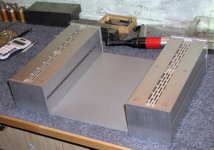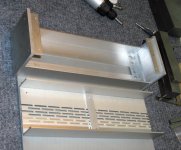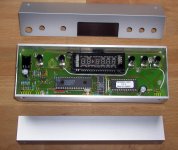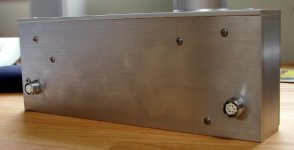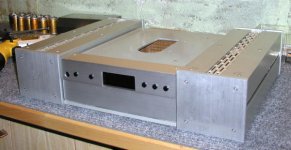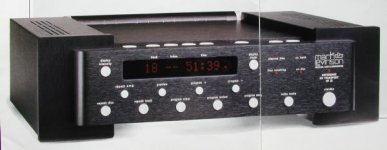The base that houses the transport mechanism goes in between towers and guess what?.. it rests on three spikes. It is not attached to bottom platform in any way in order to avoid vibrations transfer. I did the spikes from 3/8 stainless steel bolts from Home Depot and grinded them to a sharp point. If I decide to built integrated DAC it will go under. Control module (display) goes in front between towers.
Attachments
The housing of the power supplies is done almost completely from easily available and anodized extrusions from Home Depot. I just cut them, and connected with screws. The spaces help with ventilation as well give more industrial look. Took me a while of some creative thinking to make the best out of them and not look average. I guess I achieved my goal.😉
Attachments
WOW. thats all i can say. that is awesome. if you dont mind, i would like to call upon your advice when i build my chassis for alephs!
Wow! How many hours did it take you to do the chassis so far?
Your Home Depot must carry better items than my Home Depot down here. I can't find anodized extrusions here!
Your Home Depot must carry better items than my Home Depot down here. I can't find anodized extrusions here!
Hey Peter, how about publishing a set of plans, with references for materials, parts suppliers, mechanical drawings etc? I would even pay for them if it was reasonable, like $20 or $30 bucks. You could include several options for mounting, different levels of DAC accuracy that you may have come across. How about it?
I really would like to try my hand at this, skill set and tools is not a problem. I would just not know where to start without endless reading and I am already spending too much of my disposable time on this hobby (my wife's opinion not mine) 🙂
I am not sure if the final result would be a better CD player than my Toshiba 9200, but it would be fun to try.
Anthony
I really would like to try my hand at this, skill set and tools is not a problem. I would just not know where to start without endless reading and I am already spending too much of my disposable time on this hobby (my wife's opinion not mine) 🙂
I am not sure if the final result would be a better CD player than my Toshiba 9200, but it would be fun to try.
Anthony
By the way, you CD unit looks totally awsome, if there were DIY awards like the Oscars, you would get my vote.
Anthony
Anthony
Probably 15-20 hours of actual work, not counting hours spend on thinking about design and looking for tools.😉
Member
Joined 2002
i smell production line soon... lol where do we post our orders..
I like that man it is awsome..
I like that man it is awsome..
Coulomb said:
I am not sure if the final result would be a better CD player than my Toshiba 9200, but it would be fun to try.
Anthony
I hope that mine will not sound worse than that one. Otherwise I wouldn't waste so much time.😉
Attachments
Coulomb said:Hey Peter, how about publishing a set of plans, with references for materials, parts suppliers, mechanical drawings etc? I would even pay for them if it was reasonable, like $20 or $30 bucks. You could include several options for mounting, different levels of DAC accuracy that you may have come across. How about it?
I really would like to try my hand at this, skill set and tools is not a problem. I would just not know where to start without endless reading and I am already spending too much of my disposable time on this hobby (my wife's opinion not mine) 🙂
Anthony
This is a prototype. If it will sound good, I might prepare a kit with somewhat easier way of doing things. I still have to test different power supplies and at least two type of DACs: one with no oversampling the other using latest technology. So bear with me, the quest will continue.😉
Be prepared to spend at least a $1000 though (but in Canadian currency😉 ).
looks good peter.
have you thought about damping materials yet? maybe treat the inside with some sort of coating or constrained-layer damping? aluminum does tend to be a little ringy...
have you thought about damping materials yet? maybe treat the inside with some sort of coating or constrained-layer damping? aluminum does tend to be a little ringy...
Be prepared to spend at least a $1000 though (but in Canadian currency ).
If that's a thousand dollars beginning to end, I can live with that, especially if I can spend it over several months. Buy a basic kit from you and follow the instructions to the end sort of thing. Might be worth waiting a little bit while you blaze the trail ahead. 🙂 🙂
Anthony
Anthony,
I was thinking in that manner too. If the C$1000 includes everything, that's not too bad if spread over several months. Hopefully Peter is still in the country helping us with the construction support and not somewhere else doing his 6 months (only) of working.
I was thinking in that manner too. If the C$1000 includes everything, that's not too bad if spread over several months. Hopefully Peter is still in the country helping us with the construction support and not somewhere else doing his 6 months (only) of working.
Damping materials
The mechanism is mounted on 1.5" phenolic material which should provide good damping. It is mounted on 3 spikes which rest on 1/4 aluminum plate. The aluminum plate itself will rest on another 1.5' phenolic board and this is the only place where I will experiment with damping. I didn't do any damping around mechanism following the way of reasoning of Junji Kimura of 47 Laboratory:
"The platform/casing of Flatfish is a 2/3 inch thick, machined aluminum board. All the driving mechanisms, pick-up mechanisms and the circuits are directly mounted on this one piece of aluminum board.
The huge difference between the mass of the mechanisms and that of the platform (150g against 1200g) enables to cut off the vibrations caused by the slight off-centering of the disks and the tracing mechanisms returning to the bit-tracing lens itself, allowing us to minimize the amount of servo control dramatically.
This rigid and compact structure of the platform has a very small surface area to receive the vibrations, and its large mass helps to reduce the vibrations smoothly and effectively without any extra damping or suspensions.
As a result, storage of vibration energy was minimized, letting us achieve a refreshingly quick transient response. Compared to the conventional box-type chassis/casings, this platform is almost completely free from any stress of construction. Now, you can hear how much harmony and bottom-end information was obscured under those mechanical stresses."
The mechanism is mounted on 1.5" phenolic material which should provide good damping. It is mounted on 3 spikes which rest on 1/4 aluminum plate. The aluminum plate itself will rest on another 1.5' phenolic board and this is the only place where I will experiment with damping. I didn't do any damping around mechanism following the way of reasoning of Junji Kimura of 47 Laboratory:
"The platform/casing of Flatfish is a 2/3 inch thick, machined aluminum board. All the driving mechanisms, pick-up mechanisms and the circuits are directly mounted on this one piece of aluminum board.
The huge difference between the mass of the mechanisms and that of the platform (150g against 1200g) enables to cut off the vibrations caused by the slight off-centering of the disks and the tracing mechanisms returning to the bit-tracing lens itself, allowing us to minimize the amount of servo control dramatically.
This rigid and compact structure of the platform has a very small surface area to receive the vibrations, and its large mass helps to reduce the vibrations smoothly and effectively without any extra damping or suspensions.
As a result, storage of vibration energy was minimized, letting us achieve a refreshingly quick transient response. Compared to the conventional box-type chassis/casings, this platform is almost completely free from any stress of construction. Now, you can hear how much harmony and bottom-end information was obscured under those mechanical stresses."
Power supplies for transport section are almost done. Each supply consists of a separate, split bobbin transformer and heavy passive filtering (LCLRCRC)😉 . Four supplies in total: bias and filament heating for VFTD, servo decoder, motors and actuators, display PCB. They will be located in a left tower. Right tower stays empty until DAC is build.😉
Attachments
- Status
- Not open for further replies.
- Home
- Source & Line
- Digital Source
- CD PRO 2 - The making of a high end CD Transport
